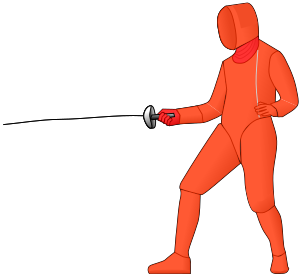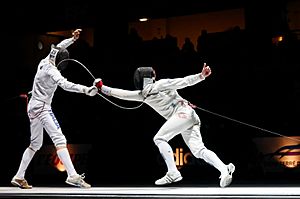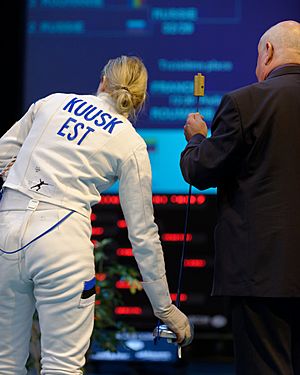Épée facts for kids
The épée (pronounced "eh-PAY") is the biggest and heaviest of the three weapons used in the sport of fencing. It comes from a 19th-century French dueling sword. This sword itself came from an older French weapon called the "small sword."
The épée is a "thrusting" weapon. This means you score points by pushing its tip into your opponent. It is different from a sabre, which is used for slashing. The épée's blade is stiffer than a foil blade. It has a triangular shape and a V-shaped groove. The épée also has a large bell-shaped guard. This guard helps protect the fencer's hand and arm. Because it is heavier, épée fencing is often seen as the slowest type of fencing.
Contents
What is Épée Fencing?
Fencing is a sport with three main weapons: the foil, the épée, and the sabre. Each weapon has its own rules and events. The épée is special because you can hit any part of your opponent's body to score a point. With other weapons, you can only hit certain areas above the waist.
Épée fencing needs a lot of focus, accuracy, and quickness. Since the whole body is a target, fencers must guess their opponent's next move. They need to strike at just the right moment.
How Épée Scoring Works
In most high-level competitions, fencers use an electric piste. This is a special metal floor that stops hits to the ground from counting as points. In épée fencing, there are no "right-of-way" rules. This means the first fencer to hit their opponent scores the point. Electronic scoring machines decide who touched first.
It is also possible for both fencers to score a point at the same time. This is called a "double-touch." For a double-touch to count, both hits must happen within 40 milliseconds (a tiny fraction of a second) of each other.
Using Counterattacks in Épée
A special move in épée is the "counterattack." This is when a fencer attacks right after their opponent attacks. Since there are no right-of-way rules, a good counterattack can be a very effective way to score. This is why you see counterattacks often in épée fencing.
Parts of an Épée Weapon
A standard épée for adult fencers is about 90 cm (35 in) long from the guard to the tip. The whole weapon weighs less than 770 g (27 oz). Most competition épées are lighter, weighing around 300–450 g (11–16 oz). Smaller and lighter épées are made for children under 13.
The Blade
The épée blade has a triangular shape. A foil blade, on the other hand, is rectangular. Neither blade has a sharp cutting edge. For electric scoring, thin wires run down a groove in the épée blade. These wires connect to a button at the tip.
The width of any side of an épée blade is limited to 24 mm (0.94 in) in competitions.
The Guard and Grip
The guard of an épée is a round, bell-shaped shield. It protects the fencer's hand. Since the hand is a valid target, the épée's guard is much larger than a foil's guard. It is about 13.5 cm (5.3 in) wide.
The grip is the part you hold. Like with a foil, you can change the grip on an épée. Common grip types include the French grip and the pistol grip.
How Electric Scoring Works
In competitions, a point is scored when the épée's tip touches the opponent with enough force to push in the tip. This needs a minimum force of 750 gf (7.4 N). The tip is wired to a connector in the guard. This connector then links to an electronic scoring device. The guard, blade, and handle of the épée are all connected to the scoring box. This stops hits to the weapon itself from counting as points.
Two thin wires run from the tip of the blade to the connector in the guard. These wires are held in place with strong glue. The tip of an electric épée is called the "button." It has a movable part that touches the opponent. There are also springs inside that make sure the tip works correctly.
Before each match, officials check the épée's tip. They make sure it needs enough force to register a hit. They also check that it does not register a hit if only a small amount of force is applied. Fencers must have at least two working weapons and two body wires during competitions. This is in case one breaks.
Épée matches often have a slow pace. But they also have sudden bursts of speed, especially when fencers use counterattacks.
History of the Épée
From Dueling to Sport
The word "épée" comes from a Latin word for sword. It became known in English in the 1880s for the sport fencing weapon.
Like the foil, the épée developed from light swords used by regular people. These swords, like the "small sword," were used for duels in the 17th century. Duels were fights, sometimes to the death.
In the 19th century, duels changed. They were often fought until one person drew "first blood." This meant you only needed to make a small cut on your opponent's wrist or arm to win. This led to swords that were good at making light touches to the arm and hand.
Modern Épée Fencing
Today, épée fencing is a bit like those 19th-century duels. Fencers must hit their target with the tip of the weapon. Unlike foil and sabre, it is not always a foul if fencers touch each other's bodies. It is only a foul if it is done with "brutality or violence."
Before electric scoring, épée fencers used tips with small spikes. These spikes would catch on the opponent's clothes or mask. This helped the referee see the hits. These spikes could make fencing painful! Later, fencers used tips dipped in dye. The dye would mark where a hit landed on a white uniform.
Today, electric weapons are used in competitions. When the tip touches the opponent, it completes an electric circuit. This signals a hit. Non-electric épées are now mostly used for practice.
In the 1970s and 1980s, a new way of thinking about épée fencing began. A coach named Eric Sollee and his student, Johan Harmenberg, led this change. Harmenberg went on to win many gold medals in fencing. This new approach focused on controlling the distance and forcing opponents into situations where the fencer was strongest. Many top fencers now use this strategy.
See also
 In Spanish: Espada (esgrima) para niños
In Spanish: Espada (esgrima) para niños
- Colichemarde




